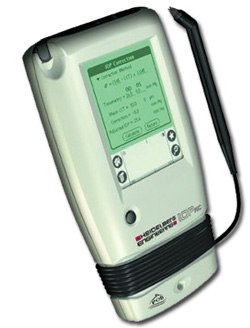Pachymetry is the measurement of the thickness of the cornea, the clear window on the front of the eye.
 A large multi-center clinical trial, the Ocular Hypertension Treatment Study, showed pachymetry to be an important measure in predicting risks for developing glaucomatous damage if patients have high intraocular pressure. When the cornea is thinner than average, patients appear to have an increased risk of developing glaucoma. In addition, patients with unusually thick corneas, are more likely to have higher than normal eye pressure readings (Intra-Ocular Pressure: IOP) but not develop glaucoma; a condition known as ocular hypertension.
A large multi-center clinical trial, the Ocular Hypertension Treatment Study, showed pachymetry to be an important measure in predicting risks for developing glaucomatous damage if patients have high intraocular pressure. When the cornea is thinner than average, patients appear to have an increased risk of developing glaucoma. In addition, patients with unusually thick corneas, are more likely to have higher than normal eye pressure readings (Intra-Ocular Pressure: IOP) but not develop glaucoma; a condition known as ocular hypertension.
There are two explanations that have been put forward to explain why patients with thin corneas are at higher risk for glaucoma progression. Firstly, the “gold standard” device for measuring intraocular pressure, the Goldmann Applanation Tonometer, is calibrated for the “average” thickness cornea. If a patient has a thin cornea, then the true pressure inside the eye is higher than what this device is recording. Secondly, when the cornea is thin, it is more likely that the other support structures of the eye, such as those surrounding the optic nerve (that is being damaged in glaucoma) are also thin and more prone to getting damage to the nerve itself or its blood supply.
Pachymetry should be performed at least once in a glaucoma patient’s adult life if the eye pressure seems to be too low to explain glaucomatous optic nerve damage or if the eye pressure is higher than one would expect in the absence of any optic nerve damage.
(c) 2009 Rob Schertzer
www.westcoastglaucoma.com